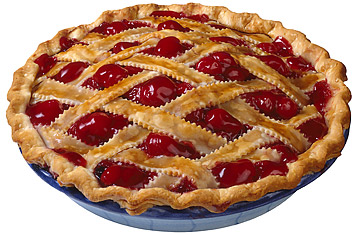
They’re simple, they’re American and come Thanksgiving, everybody saves room for them. But the pies we know today are a fairly recent addition to a history that goes back as long as mankind has had dough to bake into a crust and stuff to put inside it. In medieval England, they were called pyes, and instead of being predominantly sweet, they were most often filled with meat — beef, lamb, wild duck, magpie pigeon — spiced with pepper, currants or dates. Historians trace pie’s initial origins to the Greeks, who are thought to be the originators of the pastry shell, which they made by combining water and flour. The wealthy Romans used many different kinds of meats — even mussels and other types of seafood — in their pies. Meat pies were also often part of Roman dessert courses, or secundae mensea. Cato the Younger recorded the popularity of this sweet course, and a cheesecake-like dish called Placenta, in his treatise De Agricultura.
Contrary to grade school theater productions across the United States, there was no modern-day pie — pumpkin, pecan or otherwise — at the first Thanksgiving celebration in 1621. Pilgrims brought English-style, meat-based recipes with them to the colonies. While pumpkin pie, which is first recorded in a cookbook in 1675, originated from British spiced and boiled squash, it was not popularized in America until the early 1800s. Historians don’t know all the dishes the Pilgrims served in the first Thanksgiving feast, but primary documents indicate that pilgrims cooked with fowl and venison — and it’s not unlikely that some of that meat found its way between sheets of dough at some point. The colonists cooked many a pie: because of their crusty tops, pies acted as a means to preserve food, and were often used to keep the filling fresh during the winter months. And they didn’t make bland pies, either: documents show that the Pilgrims used dried fruit, cinnamon, pepper and nutmeg to season their meats. Further, as the colonies spread out, the pie’s role as a means to showcase local ingredients took hold and with it came a proliferation of new, sweet pies. A cookbook from 1796 listed only three types of sweet pies; a cookbook written in the late 1800s featured 8 sweet pie varieties; and by the 1947 the Modern Encyclopedia of Cooking listed 65 different varieties of sweet pies.
There are few things as American as apple pie, as the saying goes, but like much of America’s pie tradition, the original apple pie recipes came from England. These pre-Revolutionary prototypes were made with unsweetened apples and encased in an inedible shell. Yet the apple pie did develop a following, and was first referenced in the year 1589, in Menaphon by poet R. Greene: “Thy breath is like the steeme of apple pies.” (500 years later, we have “I’m Lovin’ It”, thanks to McDonald’s and its signature apple pie in an individual-serving sleeve.) Pies today are world-spanning treats, made with everything from apples to avocados. The winners of this year’s annual APC Crisco National Pie Championship included classic apple, pumpkin and cherry pies, but citrus pies, banana foster crème and Wolf Pack trail mix pies have all made the awards list. Pies have come a long way since the days of magpie and pepper, but many bakeries — including The Little Pie Shop in New York City, in the audio below — say a classic apple pie is still their top holiday seller.
More Must-Reads From TIME
- The 100 Most Influential People of 2024
- Coco Gauff Is Playing for Herself Now
- Scenes From Pro-Palestinian Encampments Across U.S. Universities
- 6 Compliments That Land Every Time
- If You're Dating Right Now , You're Brave: Column
- The AI That Could Heal a Divided Internet
- Fallout Is a Brilliant Model for the Future of Video Game Adaptations
- Want Weekly Recs on What to Watch, Read, and More? Sign Up for Worth Your Time
Contact us at letters@time.com